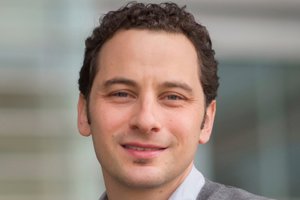Noar awarded 5-year, $3.35 million grant to develop, test e-cigarette prevention messaging

UNC Hussman School of Journalism and Media Professor Seth Noar has received a five-year, $3.35 million grant from the National Institute on Drug Abuse to lead a national study to develop and test messages that discourage adolescents from using electronic cigarettes.
Noar, also a member of the UNC Lineberger Comprehensive Cancer Center, specializes in health communication research, particularly how to harness traditional and new media to promote healthy behavioral changes among individuals and communities. This type of research involves understanding and applying behavioral theories that advance our understanding of the behavior change process; testing message design theories and frameworks to best understand what types of messages will be most resonant and persuasive with target audiences; and evaluating interventions in carefully designed randomized and quasi-experimental trials.
While cigarette smoking has declined among middle and high school students in the U.S., the use of e-cigarettes and vaping among this age group has more than doubled during the past three years. The 2019 National Youth Tobacco Survey found that 5.3 million middle and high school students reported using e-cigarettes during a 30-day period. This was up from 2.12 million students in 2017, and some researchers predict the rate of adolescent e-cigarette use will continue to climb.
“The use of e-cigarettes among adolescents is alarmingly high, prompting the FDA to call it an epidemic. It is critically important that we develop evidence-based health communication approaches to strengthen young people’s commitment to avoid vaping and prevent subsequent nicotine addiction,” Noar said. “To date, there have been a dearth of efforts to systematically develop and study communication approaches to effective e-cigarette and vaping prevention. Our study aims to address this gap.”
Noar’s work aligns with a UNC Hussman focus area — healthy communities. The school’s balance of creative and scholarly strength in both journalism and strategic communication positions Hussman faculty as thought leaders in health communication.
Noar, a member of UNC Lineberger’s cancer prevention and control program, said this new study has three aims: Identify promising ways to communicate with adolescents to prevent e-cigarette use; develop a set of e-cigarette prevention messages that reduce adolescents’ desire to try or use e-cigarettes; and use a randomized controlled trial to evaluate whether evidence-based e-cigarette prevention messages sent daily via text message will reduce at-risk adolescents’ willingness to use e-cigarettes.
“We believe our study will enable us to address a critical gap in tobacco control research by developing effective communications that strengthen adolescents’ commitment to avoid e-cigarettes and reduce e-cigarette use,” Noar said. “Our findings will inform local, state and national efforts to prevent e-cigarette use and nicotine addiction among adolescents.”
A team of doctoral students helped Noar assemble the grant proposal, including Roy H. Park Fellows Jacob Rohde and Alex Kresovich from UNC Hussman and Rachel Kurtzman from UNC Gillings, with UNC Lineberger Project Manager Hannah Prentice-Dunn managing the effort. Paschal Sheeran, and Ilona Jaspers from UNC Lineberger, and Erin Sutfin from the Wake Forest School of Medicine, are co-investigators on the study.
“The most enjoyable aspect of my job is working with students, and they are literally the engine behind all of the research that we do at UNC Hussman,” Noar said. “Getting a grant like this allows me to provide many funded opportunities for our students interested in health communication. Research is a team sport, and a key part of my job is assembling teams and giving students opportunities to work collaboratively on projects.”
A national health communication expert, Noar has led several studies focused on using targeted messages to reduce cancer risks, including graphic warning messages on cigarette packages and pairing tanning bed warning messages with images showing longer-term health effects. Last year, the National Cancer Institute awarded Noar a three-year, $1.4 million grant to conduct research focused on improving youth tobacco prevention advertisements via improved metrics for assessing their effectiveness.